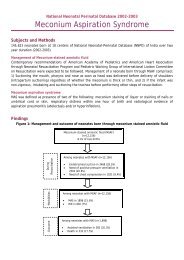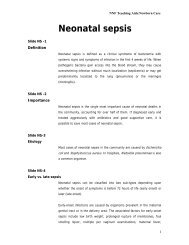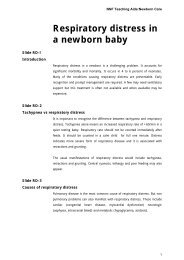Hypoglycemia in the newborn period - New Born Baby
Hypoglycemia in the newborn period - New Born Baby
Hypoglycemia in the newborn period - New Born Baby
You also want an ePaper? Increase the reach of your titles
YUMPU automatically turns print PDFs into web optimized ePapers that Google loves.
Cl<strong>in</strong>ical signs associated with hypoglycemia<br />
AIIMS- NICU protocols updated 2007<br />
a. Asymptomatic: It is also well known that low blood glucose may not manifest with any sign<br />
and may be totally asymptomatic. These babies should also be treated <strong>in</strong> view of possible<br />
adverse long term effects. 10,11<br />
b Symptomatic: Cl<strong>in</strong>ical signs of hypoglycemia <strong>in</strong> approximate order of frequency are<br />
stupor ,jitter<strong>in</strong>ess, tremors, apathy, episodes of cyanosis, convulsions, <strong>in</strong>termitant apneic spells or<br />
tachypnea, weak and high pitched cry, limpness and lethargy, difficulty <strong>in</strong> feed<strong>in</strong>g, and eye<br />
roll<strong>in</strong>g. Episodes of sweat<strong>in</strong>g, sudden pallor, hypo<strong>the</strong>rmia and cardiac arrest have also been<br />
reported<br />
Diagnosis<br />
a. Asymptomatic hypoglycemia: This diagnosis is made when <strong>the</strong> blood glucose level is below<br />
<strong>the</strong> operational threshold (to be confirmed by laboratory estimation) <strong>in</strong> <strong>the</strong> absence of cl<strong>in</strong>ical<br />
signs.<br />
b. Symptomatic hypoglycemia: This diagnosis should be made if hypoglycemia coexists with<br />
cl<strong>in</strong>ical symptomatology. Neonates generally present with nonspecific signs that result from a<br />
variety of illnesses. Therefore, careful evaluation should be done to look for all possible causes<br />
especially those that can be attributed to hypoglycemia.<br />
If cl<strong>in</strong>ical signs attributable to hypoglycemia persist despite <strong>in</strong>travenous glucose, <strong>the</strong>n o<strong>the</strong>r<br />
diagnostic possibilities should be strongly considered.<br />
Time schedule for screen<strong>in</strong>g<br />
There is a paucity of <strong>the</strong> literature that looks <strong>in</strong>to optimal tim<strong>in</strong>g and <strong>the</strong> <strong>in</strong>tervals of glucose<br />
monitor<strong>in</strong>g. Lowest blood sugar values are seen at 2 h. IDMs frequently experience<br />
asymptomatic hypoglycemia very early viz 1 to 2 hours and rarely beyond 12 hours (range 0.8 to<br />
8.5 h), support<strong>in</strong>g early screen<strong>in</strong>g for this population. However, preterm and SGA may be at risk<br />
up to 36 h (range 0.8 to 34.2 h). 12 Few SGA and preterms may develop hypoglycemia when<br />
feed<strong>in</strong>g is not established. Based on <strong>the</strong>se assumptions and current knowledge, Table 2<br />
elaborates <strong>the</strong> schedule and frequency of monitor<strong>in</strong>g <strong>in</strong> different situations<br />
Downloaded from www.<strong>newborn</strong>whocc.org<br />
5








